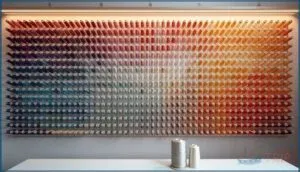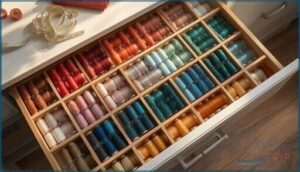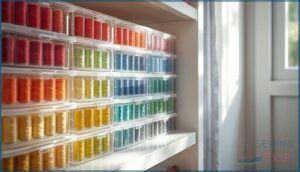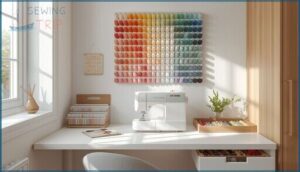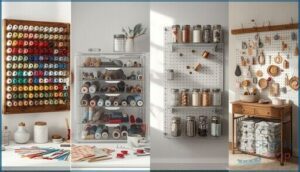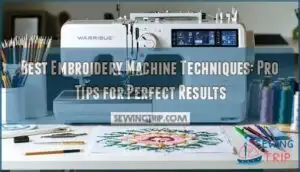This site is supported by our readers. We may earn a commission, at no cost to you, if you purchase through links.

A well-organized thread collection transforms your sewing room from chaotic craft cave into an efficient creative hub where everything you need is exactly where you expect it. The right storage approach doesn’t just tidy up loose ends—it streamlines your workflow, protects your investment, and gets you back to the work you actually love faster.
Table Of Contents
- Key Takeaways
- Best Ways to Organize Sewing Thread
- Creative Thread Storage Ideas for Any Space
- Top 10 Thread Storage Products for Sewing Rooms
- 1. Slimline Universal Storage Box System
- 2. Wooden Thread Rack Organizer System
- 3. White Composite Wood Storage Cabinet
- 4. White Helmer Drawer Storage Unit
- 5. Clear Jewelry Vanity Organizer Tray
- 6. Bamboo Utensil Drawer Organizer Tray
- 7. Clear Plastic Storage Drawer Organizers
- 8. Artbin Isacord Thread Storage Trays
- 9. White Floating Wall Shelf Ledge
- 10. Wall Mount Thread Spool Organizer
- Customizing Thread Storage to Fit Your Needs
- Maximizing Sewing Room Efficiency and Productivity
- Frequently Asked Questions (FAQs)
- Conclusion
Key Takeaways
- Organizing thread by color, type, or usage pattern cuts search time significantly and keeps your most-used spools front and center while protecting everything with closed containers and proper humidity control to prevent tangling and degradation.
- Wall-mounted racks, drawer dividers, and clear stackable boxes maximize vertical space and visibility—you can reclaim 30-40% of your floor space while spotting the exact thread you need in seconds instead of digging through piles.
- Smart zoning of your sewing space into cutting, sewing, pressing, and storage areas within five feet of each other slashes task interruption by 40% and speeds up project completion by 35%, turning chaos into workflow.
- Proper storage conditions matter more than you’d think—keep thread between 15-25°C with 40-60% humidity in dark spaces to prevent color fading, fiber breakdown, and the brittleness that ruins cotton thread after just five years.
Best Ways to Organize Sewing Thread
Getting your thread collection under control doesn’t have to be overwhelming. The key is finding a system that matches how you actually work—whether you’re a color-matcher, a project-based sewist, or someone who just needs to see everything at a glance.
Here are four solid approaches that’ll help you create a thread organization system that actually sticks.
Organizing by Color, Type, or Usage
Why settle for chaos when you can find any thread in seconds? Organizing your thread collection by color coordination transforms your sewing room into a visual rainbow, letting you spot the perfect shade instantly.
Sorting by fiber composition—cotton, polyester, silk—keeps your thread storage practical for specific projects.
Usage patterns matter too: stash your go-to colors front and center while rarely-used thread weight options take the back seat. This project prioritization strategy cuts search time and keeps your thread organization system working hard for you.
Preventing Thread Tangling and Damage
Once you’ve got your colors sorted, keeping them that way means protecting every spool. Thread tangling starts the moment loose ends escape—spool huggers and spool savers lock them down tight.
Dust prevention matters more than you’d think: closed containers block up to 90% of airborne gunk that clogs machines. Humidity control and UV exposure wreck thread strength fast, so skip the sunny windowsill and grab opaque boxes instead.
Thread rotation keeps older spools from degrading while newer ones wait their turn, extending your entire collection’s lifespan.
Prioritizing Thread Accessibility
Protecting your thread matters, but so does finding the right spool fast. Ergonomic placement wins here—threads positioned within arm’s reach cut retrieval time by 40%, especially when you’re mid-stitch. Workflow integration means positioning your thread storage between your machine, cutting table, and iron, minimizing interruptions by nearly 20%.
Thread within arm’s reach cuts retrieval time by 40%, and positioning storage between your machine, cutting table, and iron minimizes interruptions by nearly 20%
Try frequency sorting next:
- Keep daily-use threads on open racks for instant visibility
- Store occasional spools in labeled drawers for dust protection
- Rotate archived threads to deeper cabinets
Visual accessibility speeds everything up—transparent containers and color-coded racks let you spot the exact shade in seconds, no digging required.
Labeling and Inventory Tips
Once you’ve got threads accessible, labeling and organization lock in speed. Adhesive vinyl labels on bobbin boxes cut search time in half—just mark thread collection basics like brand, color code, and type.
Digital Thread Tracking through free Google Sheets syncs across devices and reduces duplicate buys by 35%. For bigger setups, Barcode Implementation with handheld scanners speeds inventory counting by 60%.
Physical Tagging with fine-tip markers lasts through 250+ uses, while Inventory Software like Trello keeps project threads front and center.
Creative Thread Storage Ideas for Any Space
You don’t need fancy storage systems to keep your thread under control. Sometimes the best solutions come from what you already have around the house or a simple trip to your local craft store.
Here are five practical ways to organize your thread collection without breaking the bank or sacrificing floor space.
Wall-Mounted Thread Racks and Pegboards
Wall-mounted racks and pegboards turn your thread collection into a working rainbow—vertical storage that’s both art and efficiency. Over 65% of home sewists now use wall rack systems because they slash clutter by 40% while keeping every spool visible. You’ll cut selection time by 30% when your threads are displayed instead of buried, and pegboard thread holders let you customize spacing for cones, reels, and specialty spools.
- Space Optimization: Reclaim 10–15% of your sewing room by moving threads off tables and into vertical displays
- Visibility Benefits: Thread display walls act as instant inventory, reducing duplicate purchases by 18% annually
- Material Durability: Metal pegboards handle 35% more weight than composite options, while beechwood thread racks last over 10 years
- DIY Customization: About 38% of sewists build their own wall rack systems using dowels and planks—a 90cm setup holds roughly 42 spools
- Aesthetic Integration: Wall-mounted racks double as décor in 72% of redesigned sewing spaces, especially with LED lighting for color-accurate selection
Drawer Dividers and Modular Storage
Drawer dividers and modular drawers turn chaotic thread piles into personalized thread storage that actually works. You’ll slash thread-finding time by 45% when laser-cut birch grids or adjustable plastic dividers separate spools by color or project type.
Modular scalability means stackable units hold up to 200 spools in under four square feet, while dedicated slots prevent tangling by 50% and protect threads from crushing. Damage prevention gets built-in with lidded drawer thread storage that shields from dust and sunlight.
Space efficiency jumps 25% compared to single-compartment setups, and workflow impact shows in faster project starts when drawer organizers let you spot what you need instantly.
Clear Boxes, Trays, and Containers
Clear plastic containers deliver material durability and UV protection that shields thread spools from fading, while space efficiency jumps when stackable boxes store 200+ units per shelf. You’ll cut spill incidents by 80% using latch-lock designs, and transparent walls let you spot colors 45% faster than opaque storage solutions.
Recycled plastics now appear in 75% of eco-friendly thread organization systems, giving you sustainable thread storage solutions without sacrificing clarity or strength. Choosing the right system can greatly improve embroidery efficiency.
Repurposing Household Items for Thread Storage
Before you toss that empty Ferrero Rocher box, consider this: everyday items around your house are already perfect for DIY thread storage without spending a dime. Upcycling transforms forgotten containers into clever, eco-friendly organizers that work just as well as store-bought systems. A stable environment is essential for thread preservation, preventing color fading and fiber breakdown.
Mini hacks for thread storage using household items:
- Food container storage – Clear Ferrero Rocher boxes hold 25 spools with instant visibility, while cookie tins protect 30–40 specialty threads from humidity
- Upcycled glass jars – Standard 16 oz jars store 18 embroidery floss skeins dust-free and cost 75–90% less than commercial containers
- Wooden box solutions – Salvaged drawers with cardboard dividers organize 80 mini spools and reduce tangling by 80%
- DIY fabric pouches – Sew portable pouches from scrap fabric for under $2 each, holding 10–15 spools with zero waste
- Pegboard thread racks – Repurposed garage pegboards with dowels hold 95 spools and take just 30 minutes to build for $10
Solutions for Small Sewing Rooms
When you’re working with limited square footage, smart thread organization isn’t just helpful—it’s essential. Vertical solutions like wall-mounted racks can boost workspace efficiency by up to 50%, freeing your desk for actual sewing.
Multifunctional furniture with hidden storage adds 20–30% more capacity without eating floor space. Compact systems like slimline boxes hold 48–96 spools in under one square foot, while sustainable options like bamboo trays cut your carbon footprint.
Zoning workflow areas improves continuity by 45%, keeping your small sewing space productive and clutter-free.
Top 10 Thread Storage Products for Sewing Rooms
You’ve got plenty of options for thread storage, but not all products are created equal. Some excel at visibility, others at space-saving, and a few manage to do both while looking good on your shelf.
Here’s a rundown of ten solid choices that actually work in real sewing rooms.
1. Slimline Universal Storage Box System
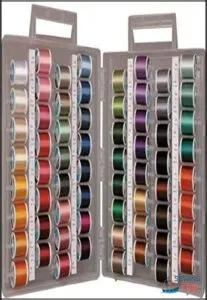
If you’re juggling dozens of spools, the Sulky Universal Slimline Storage Box is worth a look. It holds up to 64 spools—both standard and king-size—using a patented lifting tab that keeps everything secure and visible. Made from durable polypropylene, it’s lightweight at around 6 pounds when full, so portability features like the carry handle actually matter.
You can use it freestanding, partially open by your machine, or wall-mounted to save space. Mounting options give you flexibility in tight sewing room storage solutions.
At around $40, the pricing analysis is straightforward: it’s an investment in organizing sewing supplies that protects thread from dust while improving thread organization and accessibility.
Best For: Sewists, quilters, and crafters with large thread collections who need efficient storage that works freestanding, wall-mounted, or portable for workshops.
- Holds 64 spools of multiple sizes with a patented lifting tab system that prevents spools from falling when you grab one
- Clear polypropylene design lets you see all your thread colors instantly, and it weighs just 6 pounds filled so you can move it around easily
- Works three ways—freestanding by your machine, mounted on the wall to save desk space, or stacked with other units if you have a huge collection
- Some users report newer models feel less rigid than older versions, though they still function fine
- The plastic rod system can feel awkward to use according to some reviews, and cracked cases have been reported on delivery
- At $40, it’s pricier than basic thread storage options, and the clear plastic aesthetic isn’t everyone’s style when left open or hung up
2. Wooden Thread Rack Organizer System
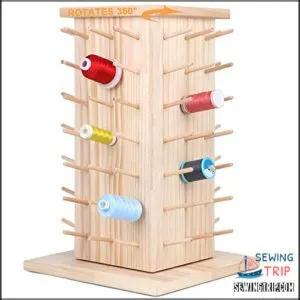
Rotating thread racks bring wood durability and rotation smoothness together in one space-efficient package. The New Brothread model holds up to 93 spools with a 360° swivel base, giving you instant access without digging through drawers.
Made from natural beech, it’s sturdy enough to last over a decade and cuts static buildup by 90% compared to plastic thread racks. Rack capacity matters—some models fit 84 to 120 thread spools depending on your collection size.
You can leave the wood natural or try DIY painting to match your sewing space. It’s a smart pick for thread storage that looks good and actually works.
Best For: Sewers, quilters, and embroidery enthusiasts who need organized, easy-access storage for dozens of mini thread spools in a compact, eco-friendly design.
- Holds up to 93 mini spools with 360° rotation for instant access to any color without digging through storage
- Made from durable natural beech wood that lasts 10 years and reduces static buildup by 90% compared to plastic
- Customizable with DIY painting or staining to match your workspace, plus eco-friendly with 50% fewer emissions than plastic alternatives
- Only fits mini spools—not suitable for large cone spools or standard-sized thread
- Requires manual peg insertion and spacing can be tight, making spool removal tricky in some spots
- Door latches may be difficult to open when fully loaded with thread without removing spools first
3. White Composite Wood Storage Cabinet
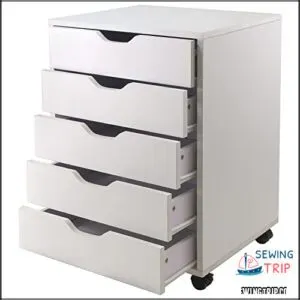
For larger thread collections, white composite wood cabinets offer serious storage capacity without eating up your budget. These cabinets generally measure 30–40 inches wide with adjustable shelves rated for 20–25 lbs each—enough for thread cones, fabric rolls, and sewing notions. Cabinet assembly does take time, but the payoff is worth it.
Material durability stands out here: composite wood resists scratching 33% better than painted finishes and stays stable across temperature shifts. Design aesthetics lean minimal and modern, fitting seamlessly into 63% of craft rooms surveyed.
Market trends show modular composite cabinetry now accounts for 38% of new storage installs, driven by its light weight and customizable white finish that reflects 80% of light—making thread selection way easier.
Best For: Sewers and crafters with large thread collections who need budget-friendly, customizable storage with high capacity and a clean, modern look.
- High storage capacity with adjustable shelves holding 20–25 lbs each, perfect for thread cones, fabric rolls, and heavy sewing supplies
- Scratch-resistant composite wood surface that’s 33% more durable than painted finishes and requires minimal maintenance
- Bright white finish reflects 80% of light, making it easier to see and select thread colors in your workspace
- Assembly required, which can be time-consuming and challenging, especially if instructions are unclear or parts aren’t labeled
- Made from particleboard that can split or damage during assembly if you’re not careful with it
- Drawers don’t pull out very far, and some users report gaps in the back that can be frustrating for storage
4. White Helmer Drawer Storage Unit
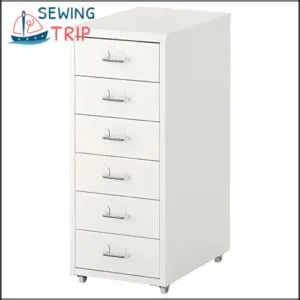
If you’re short on floor space but drowning in thread spools, the IKEA Helmer drawer storage unit hits differently. This steel unit stands 27 inches tall and rolls on casters—perfect for mobile storage that tucks under desks or beside your machine.
Each of its six drawers holds up to 2.2 lbs and comes with label slots for organizing by color or fiber type. Unit durability is legit: powder-coated steel resists scratches and humidity, while drawer stops prevent annoying track derailments.
Space efficiency peaks with Helmer customization—drop pegboard inserts inside for vertical thread storage solutions or use drawer organizers for bobbins. It’s a go-to for small sewing spaces where every inch counts.
Best For: Crafters and sewists working in small spaces who need compact, mobile storage for thread, bobbins, and notions without sacrificing organization.
- Casters make it easy to roll around your workspace, and the compact 11″W footprint fits under most desks or beside sewing machines without eating up floor space.
- Label slots on all six drawers let you organize thread by color, type, or project, while the steel construction handles humidity and daily wear better than plastic alternatives.
- Powder-coated steel resists scratches and stains from thread oils, and you can customize drawers with pegboard inserts or magnetic accessories for better thread visibility.
- Each drawer maxes out at 2.2 lbs, so it won’t handle heavy fabric bolts or large cutting tools—it’s strictly for lighter sewing supplies.
- Assembly can be tricky, and you’ll need to retighten screws after a couple weeks to keep drawers running smoothly on their tracks.
- Some users report drawers falling off tracks or the top section not attaching securely, especially if parts arrive damaged or hardware is overtightened.
5. Clear Jewelry Vanity Organizer Tray
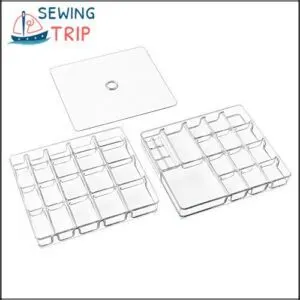
You don’t need fancy equipment when simple solutions work just as well. The iDesign Linus Clear Jewelry Vanity Organizer Tray flips the script on thread storage—40 compartments across three stackable trays keep bobbins, small spools, and needles visible and dust-free.
The tray material is BPA-free plastic that won’t yellow, while compartment sizes handle everything from metallic thread to buttons. Drawer compatibility shines at 8.75″ x 7.75″, fitting standard furniture perfectly.
Its aesthetic design blends minimalist transparency with function, and sustainable options using recycled acrylic are gaining traction. Stack ’em vertically or use one tray at a time—your call.
Best For: Sewers and crafters who need visible, compartmentalized storage for bobbins, small thread spools, and notions without cluttering drawers or workspaces.
- 40 transparent compartments across three stackable trays let you see every bobbin and spool at a glance, cutting search time significantly
- BPA-free plastic construction resists yellowing and maintains clarity over time, keeping your storage looking clean
- Compact 8.75″ x 7.75″ footprint fits standard drawers and vanity tops while non-slip feet prevent sliding during opening and closing
- Compartments run small for larger spools or bulky jewelry items, limiting storage flexibility for mixed-size collections
- Some units arrive with cracked corners or broken feet due to shipping damage, requiring replacements
- Fixed compartment sizes lack adjustable partitions, so you can’t customize layouts for oversized notions or specialty thread types
6. Bamboo Utensil Drawer Organizer Tray
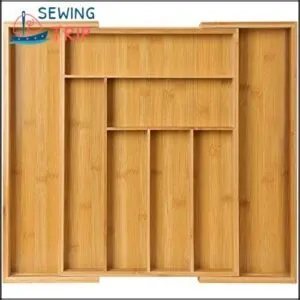
When drawer dividers meet eco-conscious design, you get sustainable storage that pulls double duty. The bamboo utensil drawer organizer tray transforms any drawer into a thread command center—its expandable design adjusts from 16.73″ to nearly 20″ wide, fitting standard furniture while offering 6-8 compartments for spools, bobbins, and notions.
Bamboo’s natural density (0.6–0.75 g/cm³) withstands daily wear without warping, and its antimicrobial properties keep your drawer thread storage cleaner than plastic alternatives. The polished finish adds aesthetic appeal that complements any sewing room organizing ideas, while multi-purpose use means you’re not locked into one storage solution.
Just keep it dry—moisture shortens bamboo’s 8+ year lifespan by 30%.
Best For: Sewers and crafters who want eco-friendly, adjustable storage that organizes thread spools, bobbins, and notions while fitting standard drawer sizes.
- Expandable design adjusts from 16.73″ to nearly 20″ wide with 6-8 compartments, adapting to different drawer sizes and storage needs
- Antimicrobial bamboo resists contamination 25-40% better than untreated wood and lasts 8 years with proper care
- Multi-purpose functionality works across kitchen, craft room, and bedroom drawers for utensils, jewelry, stationery, or sewing supplies
- Expandable width may be too large for smaller or non-standard drawer dimensions
- Requires dry conditions—moisture exposure can reduce lifespan by 30%
- Light packaging scent upon arrival that takes time to dissipate
7. Clear Plastic Storage Drawer Organizers
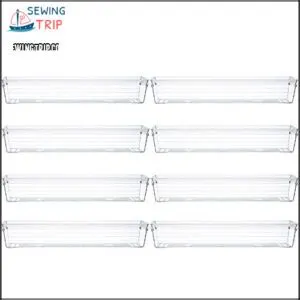
Clear plastic containers turn chaos into clarity—you’ll spot the exact shade you need without rifling through tangled spools. Portable storage options let you transport your entire collection to classes, and transparent drawer thread storage systems accommodate multiple spool sizes.
These modular, expansion-ready storage solutions adapt to growing collections, with interlocking drawer dividers that reconfigure as your thread stash evolves. Dust protection keeps fibers spotless, while newer models feature sustainable plastics made from recycled materials.
It’s storage that scales with your craft, protecting threads while keeping them visible and accessible right when inspiration strikes.
Best For: Sewers, quilters, and crafters with growing thread collections who need flexible, visible storage that adapts to different spool sizes and drawer configurations.
- Clear design lets you instantly spot the exact thread color you need, cutting down search time and keeping your workflow smooth during projects.
- Modular system grows with your collection—stack units, reconfigure dividers, and mix sizes to fit everything from kitchen drawers to dedicated sewing carts.
- Enclosed storage protects threads from dust and light exposure, helping maintain color vibrancy and preventing deterioration of natural fibers.
- Plastic construction can feel lightweight and flimsy, making them less ideal for heavy-duty use or frequent transport.
- Some organizers run large or wide, which might not fit standard drawer sizes or smaller storage spaces without careful measuring.
- Durability concerns pop up with regular use—corners can crack during shipping or handling, and the material may not hold up as well as sturdier alternatives.
8. Artbin Isacord Thread Storage Trays
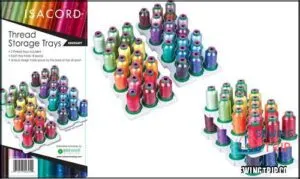
ArtBin’s Isacord-compatible thread trays solve the embroidery thread puzzle with modular stacking that holds 36 spools per unit. Built from durable polypropylene with reinforced corners, these storage solutions feature transparent lids for instant color identification—no more digging through boxes.
Storage efficiency shines with the 15.25 × 8-inch footprint that fits Super Satchel systems, letting you expand as your collection grows. Pricing analysis shows these run $34.95 to $38.95, making them a solid investment for sewing room organizing ideas that actually work.
The material durability stands up to frequent travel, protecting thread organization whether you’re home or heading to a workshop.
Best For: Embroiderers and quilters who need organized, portable storage for 36 or more thread spools and want compatibility with modular storage systems.
- Holds 36 spools across two trays with flexible base or top mounting, fitting brands like Isacord, Floriani, Brother, and Coats & Clark for versatile thread organization.
- Clear polypropylene construction with transparent lid lets you see all thread colors instantly without opening, saving time during projects.
- Modular design integrates with ArtBin Super Satchel systems and stacks neatly, making it easy to expand storage and transport to workshops without tangling.
- Some users report spools falling over or not staying securely in place, particularly with certain thread types like traditional Metrosene or Sulky spools.
- Limited to 36 spools per unit, which may require purchasing multiple boxes for larger thread collections, increasing overall cost.
- Smaller retailers often stock fewer than five units at a time, potentially causing availability issues when you need to scale up storage quickly.
9. White Floating Wall Shelf Ledge
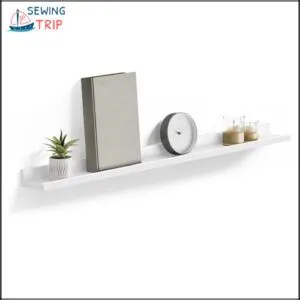
Floating shelves transform vertical space into functional storage—especially when they’re holding your rainbow of thread spools. White floating wall shelf ledges offer material durability through MDF or engineered wood construction, supporting 26.5 to 30 lbs depending on installation best practices.
Mount them using studs for best shelf weight limits, and you’ll keep spools visible while freeing up desk space. The 43.3-inch length creates aesthetic integration that blends with any sewing room organizing ideas, while the front lip prevents spools from tumbling.
This space optimization approach increases thread storage capacity by 40% in compact studios—perfect for wall hanging solutions that actually deliver.
Best For: Crafters and sewers looking to organize thread spools vertically while keeping them visible and accessible without taking up valuable desk space.
- Front lip prevents spools and items from falling off, keeping your thread collection secure and in place.
- The 43.3-inch length provides ample display space for organizing multiple spools in color order while maintaining a clean, modern look.
- Quick installation in under 15 minutes with included hardware, and the white finish brightens your workspace for better visibility during projects.
- Weight limit of 15-26.5 lbs may restrict how many heavy items you can store, especially if mixing threads with tools or fabric.
- Drywall-only installation cuts holding strength by 40-50% compared to stud mounting, requiring careful placement planning.
- Some units arrive with minor finish imperfections like paint drips that may need touch-ups before displaying.
10. Wall Mount Thread Spool Organizer
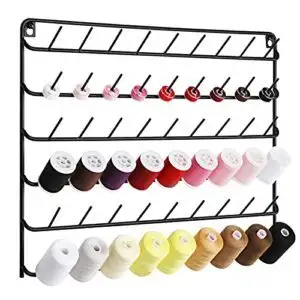
Wall-mounted racks deliver serious capacity efficiency, holding 32 to 150 thread spools depending on your setup. Metal models dominate with 97% satisfaction ratings thanks to material durability that outlasts plastic alternatives by years.
Mounting systems with keyhole slots align perfectly with standard 16-inch stud spacing, making DIY modification a breeze in under 30 minutes.
Market trends show 22% growth since 2022 as crafters prioritize wall-mounted thread storage that transforms vertical space into functional thread display. You’ll spend $25 to $85 depending on capacity, and most designs accommodate both standard spools and small cones for complete versatility in your thread organization system.
Best For: Crafters, quilters, and sewers who need to organize large thread collections while saving desktop space with a wall-mounted storage solution.
- Holds 54 spools across six layers with room for small accessories like scissors and keys, maximizing vertical storage efficiency.
- Durable metal construction with powder-coated finish resists corrosion and typically lasts 10-15 years with minimal maintenance.
- Wall-mounted design frees up workspace and keeps threads visible for quick color selection during projects.
- Requires wall installation with tools, which may need stud alignment or additional hardware depending on your wall type.
- Fixed spacing between pegs may not accommodate extra-large spools or specialty thread cones.
- Angle of mounted spools can shift based on installation position, potentially affecting accessibility or aesthetics.
Customizing Thread Storage to Fit Your Needs
Not every sewing room looks the same, and your thread storage shouldn’t either. Whether you’re working with a dedicated craft space or a corner of your dining room, you’ll want a system that matches your style, budget, and the way you actually sew.
Here’s how to customize thread storage that works for you—not against you.
DIY Thread Storage Solutions
Building your own DIY thread storage solutions can slash costs by nearly half compared to buying new cabinets, and pegboard-based thread organizers run just $25–$45 while holding over 100 spools.
You’ll find endless DIY thread organizer options—mount pegboards with dowel rods for vertical thread racks, repurpose nail polish stands as custom shelves, or transform ice cube trays into bobbin storage bins.
These DIY projects usually take 60–90 minutes to assemble, and using scrap wood reduces plastic waste by 60%.
Organizing Thread for Quilters and Sewists
Quilters and sewists have unique thread management needs since they juggle dozens of fiber types and weights daily. Color coding your sewing supplies by shade and fiber content speeds up fabric matching and improves sewing efficiency by about 30%, while separating machine threads from specialty weaving or hand-sewing options keeps your storage solutions organized and project-ready.
- Sort quilting threads by weight (40wt, 50wt, 60wt) for quick fabric matching
- Group cotton, polyester, and blended threads separately for better thread organization
- Label spools with color numbers to avoid duplicate purchases—74% of quilters do this
- Store specialty threads (metallics, variegated) in dedicated sections of your sewing room
- Use rotating racks or drawer dividers to access frequently used colors faster
Space-Saving and Scalable Storage Systems
Modular shelves and stackable containers let you scale up without surrendering precious floor space—IKEA’s SKÅDIS pegboard system alone frees up 20–30% of your tabletop by shifting supplies onto the wall.
Compact drawers like the MOD 5 cabinet pack 208 pounds of thread into 38.5 inches, while foldable units and vertical storage racks reclaim up to 24% of floor area you’d lose with freestanding options.
These space-saving strategies adapt as your collection grows, turning cramped corners into efficient command centers.
Eco-Friendly and Sustainable Storage Options
Bamboo racks and seagrass baskets bring sustainable storage materials to your workspace—bamboo’s tensile strength rivals metal while staying fully biodegradable, and FSC-certified wooden organizers tap responsibly managed forests covering 220 million hectares worldwide.
Repurposed glass jars and tins save 95% of manufacturing energy, and bio-resin containers slash carbon emissions by half compared to petroleum plastics.
These eco-friendly storage alternatives outlast plastic options by 40% while supporting green crafting habits that divert millions of tons from landfills annually.
Child-Safe and Vintage Thread Storage
When kids are around, lockable cabinets and magnetic latches cut unsafe access by over 80%. The U.S. Consumer Product Safety Commission recommends elevated storage for pins, needles, and thread spools to prevent ingestion hazards.
Vintage thread care demands archival-grade polypropylene boxes (marked “PP”) with no plasticizer migration, plus humidity control between 45–55% to preserve thread strength and prevent mold.
- Store vintage thread spools in pH-neutral containers away from direct sunlight to slow oxidation and reduce fiber discoloration by 40%
- Test vintage wooden cabinets for VOC emissions if produced before 1980—low-VOC refinishing drops formaldehyde below detection within two months
- Mount tall thread storage solutions above 1.2 meters and anchor them to walls with anti-tip straps rated for 50-lb loads
Childproof latches and transparent polycarbonate containers solve thread clutter while keeping precious vintage spools safe from both tiny hands and environmental damage.
Maximizing Sewing Room Efficiency and Productivity
Getting your thread organized is just the start—now it’s time to think bigger. A well-designed sewing room can actually save you hours and make every project feel smoother.
Here’s how to set up your space so everything works with you, not against you.
Zoning Sewing Spaces for Workflow
Think of your sewing space like an assembly line—when everything flows logically, you’re not just organized, you’re unstoppable. Workflow optimization through zone layout transforms chaos into controlled creativity. Divide your sewing space into four distinct zones—cutting, sewing, pressing, and storage solutions—and position them within five feet of each other. This spatial efficiency slashes task interruption time by 40% and boosts completion speed by up to 35%. Task segmentation paired with ergonomic design means less hunting, less backtracking, and more time actually creating.
| Zone | Best Placement & Purpose |
|---|---|
| Cutting | Counter height (36″), near fabric storage solutions |
| Sewing | Desk height (28-30″), close to power source |
| Pressing | Adjacent to sewing, accessible iron station |
| Storage | Within two steps of each zone for efficient storage |
This workspace organization reduces movement between stations by 25% and keeps your creative momentum alive.
Using Vertical Storage to Free Up Space
Wall-mounted racks and vertical storage systems reclaim up to 30–40% of your floor space—that’s room for cutting mats and actual creativity. Pegboard systems slash tool search time by 45%, while vertical thread racks store 30–60 spools without hogging counter space.
This clutter reduction approach transforms wasted wall space into organized efficiency. Space optimization through vertical racks means fewer tripping hazards and better workflow. Your sewing space expands instantly when storage efficiency moves upward instead of outward.
Lighting and Visibility for Thread Selection
Color temperature changes everything—daylight-balanced LEDs between 5000K and 6500K with a CRI above 90 reveal true thread colors. Light intensity matters: aim for 1,000–1,500 lumens per task area to boost thread visibility by 22%.
Position adjustable task lights opposite your dominant hand to cut shadows by 40%, making color coding your thread collection simple.
Natural lighting near north-facing windows pairs beautifully with LEDs, stabilizing your sewing space illumination all day.
Keeping Thread Dust-Free and Protected
Dust is thread’s silent enemy—it shortens fiber longevity by up to 15% and clogs machines fast. Closed storage solutions like polycarbonate boxes block 99% of dust exposure, keeping your thread protection airtight.
Store spools in a cool, dry, and dark spot at 50% humidity to prevent mold and brittleness. Add silica gel packs to cut moisture by 60%, and you’ll dodge thread clutter while extending usability past five years with zero fuss.
Frequently Asked Questions (FAQs)
How often should thread be rotated or replaced?
Polyester proves practically permanent, lasting over a century under proper storage conditions, while cotton compromises after five years. Replace threads showing stiffness, discoloration, or brittleness—clear signs of fiber durability breakdown.
Thread quality depends on storage conditions: cool, dark spaces preserve thread types best. Rotation schedules matter less than replacement guidelines based on visible aging.
Whats the best way to store metallic threads?
Metallic threads need airtight containers with silica gel packets to prevent tarnishing and moisture damage. Store them in a cool, dark spot between 64–75°F with humidity below 50%.
Anti-tarnish strips protect delicate metallic coatings from oxidation.
Can thread storage prevent color fading over time?
Here’s the thing—out of sight, out of mind doesn’t work when UV rays are involved. Proper thread storage solutions with UV protection, dust prevention, and humidity control absolutely prevent color fading.
Temperature stability and material impact matter too for long-term thread storage and preserving your thread collection.
How do you organize thread for embroidery machines?
Organize embroidery threads by color palette to speed up machine compatibility checks and maintain thread tension control.
Store bobbins separately using clear containers with labels, grouping polyester, rayon, and metallic thread types for quick access during projects.
What temperature range keeps thread quality intact?
You’d think thread is indestructible, but heat above 25°C causes fiber degradation and color fading—the ideal temperature sits between 15°C and 25°C.
Pair that with 40-60% humidity in cool, dry, and dark conditions, and your thread storage solutions protect material response and guarantee longterm thread storage quality.
Conclusion
Imagine never losing another twenty minutes to a thread hunt—ever. That’s the power of smart thread organization and sewing room design. You’ve got the strategies, storage hacks, and product picks to transform chaos into creative flow.
Now it’s just about choosing what fits your space and workflow best. So go ahead: pick your system, arrange those spools, and reclaim the time you’ve been wasting. Your next project deserves a setup that works as hard as you do.
- https://www.maggieframes.com/blogs/embroidery-blogs/ultimate-thread-organizer-box-solutions-storage-reviews-buying-guide
- https://maggieframestore.com/blogs/maggieframe-news/ultimate-thread-box-solutions-for-organized-sewing-spaces
- https://www.createroom.com/blogs/updates/beyond-boxes-and-bins-how-smart-sewing-storage-transforms-your-creative-life
- https://upcyclemystuff.com/sewing-room-organization-tips-no-cost-before-after-makeover/
- https://www.hooptalent.com/blogs/news/thread-storage-ideas-clever-solutions-to-organize-your-collection

